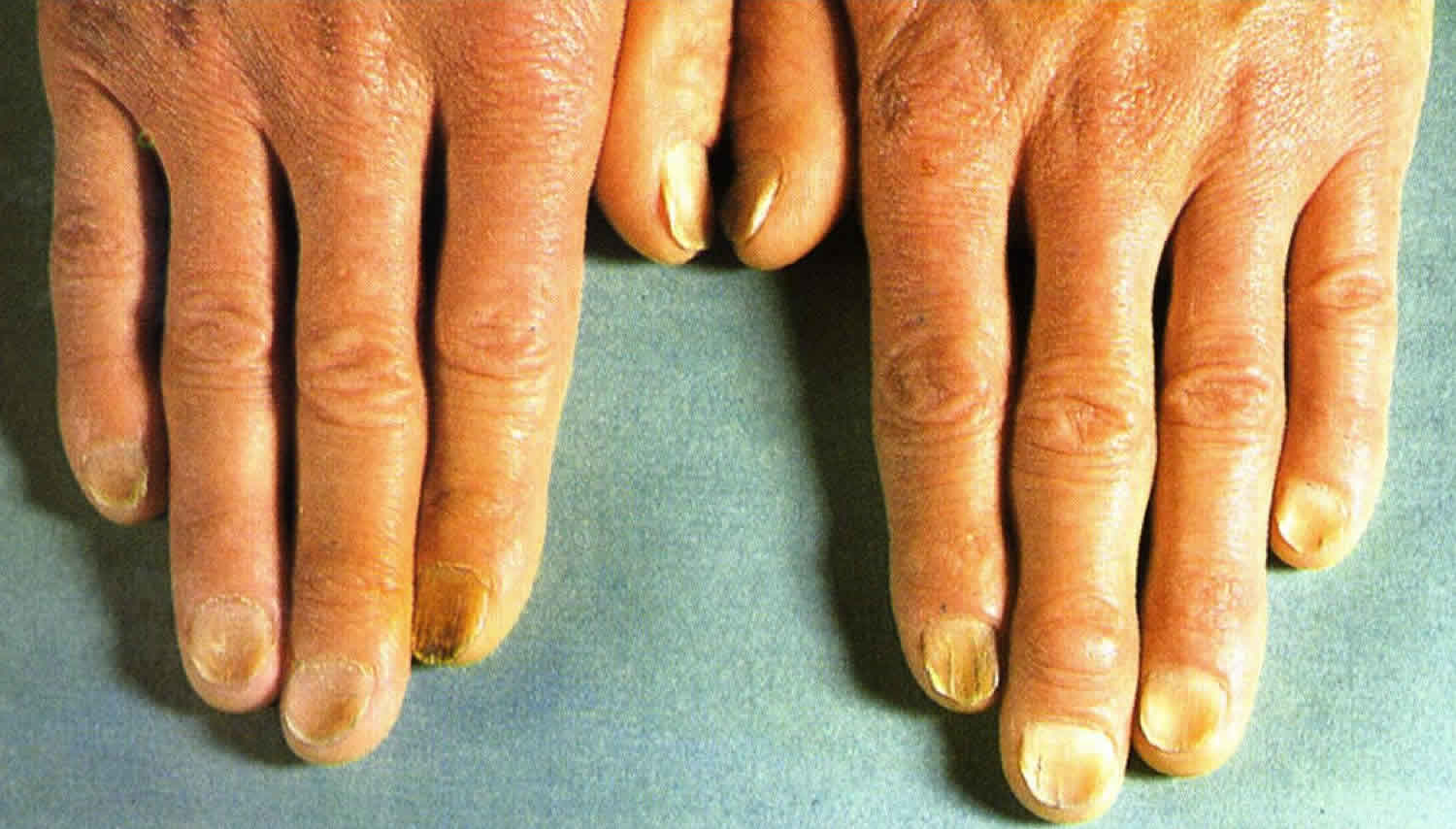Koilonychia
Koilonychia also known as spoon nails or spoon‐shaped nails, are soft nails that look scooped out. Koilonychia refers to abnormally thin nails (usually of the hand) which have lost their convexity, becoming flat or even concave in shape. The depression usually is large enough to hold a drop of liquid. Often, spoon nails are a sign of iron deficiency anemia or a liver condition known as hemochromatosis, in which your body absorbs too much iron from the food you eat. Spoon nails can also be associated with heart disease, diabetes, protein deficiency, connective tissue disease, high altitude (Ladakhi koilonychia) 1, nail exposure to solvents, petrochemicals, lye (potassium hydroxide) 2 and acitretin treatment, hypothyroidism 3 and Plummer-Vinson syndrome 4. Spoon nails are more common in adults than children 5.
Normally, the nail is firmly attached to bone by vertical dermal connective tissue bundles in the subungual area, which bond directly to the periosteum. Koilonychia is most frequently due to local rather than systemic factors (see Table 1 below). Occupational koilonychia is often associated with mild nail plate surface abnormalities and nail plate discoloration/pigmentation 6.
Koilonychia causes
Koilonychia (spoon‐shaped nail) and platynychia (flat nails) are usually associated with chronic iron deficiency anemia. The usual causes are iron deficiency secondary to gastrointestinal losses, nutritional deficiency secondary to poor intake, and/or malabsorption (e.g., celiac disease) or intestinal worms (e.g., Hookworm infestation) 7. Abnormally heavy periods (menorrhagia) and menometrorrhagia (abnormally heavy, prolonged, and irregular periods) are one of the commonest causes of chronic iron deficiency in women 8. Esophageal webs in patients with iron deficiency anemia are known as Plummer–Vinson syndrome or Patterson–Brown–Kelly syndrome 9.
Spoon nails can also be associated with hemochromatosis, heart disease, diabetes, protein deficiency, connective tissue disease, high altitude (Ladakhi koilonychia) 1, nail exposure to solvents, petrochemicals, lye (potassium hydroxide) 2 and acitretin treatment, hypothyroidism and Plummer-Vinson syndrome.
Table 1. Common causes of koilonychia
| Idiopathic | |||||
| Physiological | Early childhood | ||||
| Congenital | LEOPARD syndrome | ||||
| Ectodermal dysplasias | |||||
| Trichothiodystrophy | |||||
| Nail-patella syndrome | |||||
| Acquired | Metabolic/endocrine | Acromegaly | |||
| Hemochromatosis | |||||
| Iron deficiency | |||||
| Porphyria | |||||
| Renal dialysis/transplant | |||||
| Thyroid disease | |||||
| Dermatoses | Alopecia areata | ||||
| Darier disease | |||||
| Lichen planus | |||||
| Psoriasis | |||||
| Raynaud disease | |||||
| Exogenous | Occupational | ||||
| Traumatic | |||||
| Infections | Onychomycosis | ||||
| Syphilis | |||||
| Carpal tunnel syndrome | |||||
Koilonychia treatment
Koilonychia or spoon nails treatment treating the underlying cause. For example, iron replacement therapy corrects the iron deficiency and leads to resolution of the anemia.
References- Yanamandra U, Mukherji R, Patyal S, Nair V. Ladakhi koilonychia. BMJ Case Rep. 2014;2014:bcr2013202567. Published 2014 Jan 16. doi:10.1136/bcr-2013-202567 https://www.ncbi.nlm.nih.gov/pmc/articles/PMC3902968
- Balestri R, Rech G, Girardelli CR, Piraccini BM, La Placa M. Acute Koilonychia of Fingernails due to Lye. Skin Appendage Disord. 2017;2(3-4):183–184. doi:10.1159/000453274 https://www.ncbi.nlm.nih.gov/pmc/articles/PMC5264347
- Fawcett RS, Linford S, Stulberg DL. Nail abnormalities: clues to systemic disease. Am Fam Physician 2004;69:1417–24
- Novacek G. Plummer-Vinson syndrome. Orphanet J Rare Dis 2006;1:36.
- Fawcett R. S., Linford S., and Stulberg D. L.. 2004. Nail abnormalities: clues to systemic disease. Am. Fam. Physician 69:1417–1424.
- Walker J, Baran R, Velez N, Jellinek N. Koilonychia: an update on pathophysiology, differential diagnosis and clinical relevance. J Eur Acad Dermatol Venereol. 2016;30:1985–1991.
- Kumar G., Vaidyanathan L., and Stead L. G.. 2007. Images in emergency medicine. Koilonychia, or spoon‐shaped nails, is generally associated with iron‐deficiency anemia. Ann. Emerg. Med. 49:243, 250.
- Mangla A, Agarwal N, Yu J, Telfer M. Spooning of the nails and webbing of the esophagus: koilonychia and Plummer-Vinson Syndrome. Clin Case Rep. 2015;3(12):1054–1055. Published 2015 Nov 3. doi:10.1002/ccr3.419 https://www.ncbi.nlm.nih.gov/pmc/articles/PMC4693708
- Gude D., Bansal D. P., and Malu A.. 2013. Revisiting Plummer Vinson Syndrome. Ann. Med. Health Sci. Res. 3:119–121.





